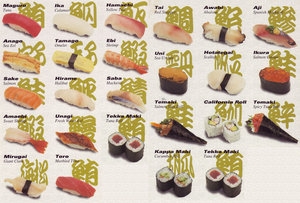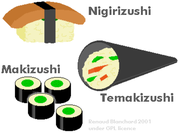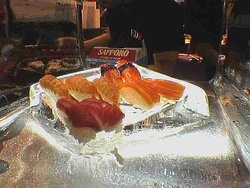Sushi
|
|

In Japanese cuisine, sushi (鮨 or 鮓 or, most commonly, 寿司) is a food made of vinegared rice combined with a topping or filling of fish, seafood, vegetables, or egg. The topping may be raw, cooked, or marinated; and may be served scattered in a bowl of rice, rolled in a strip of seaweed, laid onto hand-formed clumps of rice, or stuffed in a small tofu pouch.
In Japan the word sushi refers to a broad range of food prepared with rice. Outside Japan it is often taken to mean raw fish. Or it refers to just a few kinds of Japanese food, such as maki, or even to sashimi, which is seafood served without the rice.
| Contents |
Types of sushi
The common ingredient in all the different kinds of sushi is sushi rice. Variety arises in the choice of the fillings and toppings, in the choice of the other condiments, and in the manner it is put together. The same ingredients may be assembled in entirely different ways to different effect. This section lists the different ways to construct sushi, independent of the kinds of fillings and toppings.
- Makizushi (rolled sushi). 巻き寿司. A cylindrical piece, formed with the help of a woven bamboo mat, called a makisu. Makizushi is the form of sushi with which many Westerners are most familiar. Makizushi is generally wrapped in nori, a sheet of dried seaweed that encloses the rice and fillings.
- Futomaki (large rolls). 太巻き. A large cylindrical piece, with the nori on the outside. Typical futomaki are two or three centimeters thick and four or five centimeters wide. They are often made with two or three fillings, chosen for their complementary taste and color.
- Hosomaki (thin rolls). 細巻き. A small cylindrical piece, with the nori on the outside. Typical hosomaki are about two centimeters thick and two centimeters wide. They are generally made with only one filling, simply because there is not enough room for more than one.
- Temaki (hand rolls). 手巻き. A large cone-shaped piece, with the nori on the outside and the ingredients spilling out the wide end. A typical temaki is about ten centimeters long, and is eaten with the fingers since it is too awkward to pick up with chopsticks.
- Uramaki (inside-out rolls). 裏巻き. A medium-sized cylindrical piece, with two or more fillings. Uramaki differ from other maki because the rice is on the outside and the nori within. The filling is in the center surrounded by a liner of nori, then a layer of rice, and an outer coating of some other ingredient such as roe or toasted sesame seeds.
- Oshizushi (pressed sushi). 押し寿司. A block-shaped piece formed using a wooden mold, called an oshibako. The chef lines the bottom of the oshibako with the topping, covers it with sushi rice, and presses the lid of the mold down to create a compact, rectilinear block. The block is removed from the mold and cut into bite-sized pieces.
- Nigirizushi (hand-formed sushi). 握り寿司. Small pieces nominally similar to pressed sushi or rolled sushi, but made without using a makisu or oshibako. Assembling nigirizushi is surprisingly difficult to do well. The simplest form is a small block of sushi rice with a speck of wasabi and a thin slice of a topping draped over it, possibly tied up with a thin band of nori.
- Gunkanzushi (battleship roll). 軍艦寿司. A small, oval-shaped piece, similar in size and appearance to hosomaki. A clump of rice is hand-wrapped in a strip of nori, but instead of a filling in the center, it has some ingredient—such as fish eggs—piled on top.
- Inarizushi (stuffed sushi). 稲荷寿司. A small pouch or pocket filled with sushi rice and other ingredients. The pouch is fashioned from deep-fried tofu (油揚げ or abura age), a thin omelet (帛紗寿司 or fukusazushi), or cabbage leaves (干瓢 or kanpyo).
- Chirashizushi (scattered sushi). 散らし寿司. A bowl of sushi rice with the other ingredients mixed in. Also referred to as barazushi. ばら寿司.
- Edomae chirashizushi (Edo-style scattered sushi). Uncooked ingredients artfully arranged on top of the rice in the bowl.
- Gomokuzushi (Kansai-style sushi). 五目寿司. Cooked or uncooked ingredients mixed in the body of the rice in the bowl.
- Narezushi (なれ鮨) is an older form of sushi. A fish is stuffed with salt after its organs and scales are removed. These fish are placed in a wooden barrel doused with salt and weighed with a heavy tsukemonoishi or a pickling stone. They are fermented for ten days to a month. Then these fish are placed in water for 15 minutes to an hour. Fish are then placed in another barrel sandwiched and layered with cooled steamed rice and fish. Then it is again partially sealed with otosibuta and a pickling stone. As days pass, fermented water seeps through and these must be removed. Six months later, these "funazushi" can be eaten but it can be eaten for another six months or more.
References
Sushi1.jpg
Sushi2.jpg
Sushi3.jpg
Ingredients
All sushi has a base of a specially prepared rice, complemented with other ingredients.
Sushi rice
Sushi is made with a white, short-grained, sweet rice mixed with a dressing made of rice vinegar, sugar, salt, konbu, and sake. It is cooled to body temperature before being used.
Sushi rice (sushi-meshi) is made with Japonica rice, which has a consistency that differs from the strains commonly eaten outside of Japan. The essential quality is its stickiness. Rice that is too sticky has a mushy texture; if it is not sticky enough, it feels dry. Freshly harvested rice (shinmai) typically has too much water, and requires extra time to drain after washing.
There are regional variations in sushi rice, and of course individual chefs have their individual methods. Most of the variations are in the rice vinegar dressing: the Tokyo version of the dressing commonly uses more salt; in Osaka, the dressing has more sugar.
Sushi rice generally must be used shortly after it is made. The Wiki Cookbook has a simple recipe.
Nori
SushiRollCreation.jpg
Sushi rice being rolled into nori
The vegetable wrappers used in maki and temaki are called nori (海苔). It is an edible seaweed traditionally cultivated in one of the harbors of Japan. Originally, the plant was scraped from dock pilings, rolled out into sheets, and dried in the sun in a process similar to making paper. Nori is toasted before being used in the food.
Today, the commercial product is farmed, produced, toasted, packaged, and sold in standard-size sheets, about 18 cm by 21 cm in size. Higher quality nori is thick, smooth, shiny, and has no holes through it.
Omelette
When making fukusazushi, paper-thin omelette may replace a sheet of nori as the wrapping. The omelet is traditionally made in a rectangular omelette pan (makiyakinabe), and used to form the pouch for the rice and fillings.
The Wiki Cookbook has a sample recipe.
Toppings and fillings
- Fish
- For both sanitary and aesthetic reasons, fish eaten raw must be fresher and higher quality than cooked fish. A professional sushi chef is trained to recognize good fish, which smells clean, has a vivid color, and is free from harmful parasites. Only ocean fish are used raw in sushi; freshwater fish, which are more likely to harbor parasites, are cooked.
- Commonly-used fish are tuna, yellowtail, salmon, snapper, bonito and mackerel. The most prized sushi ingredient is known as toro, a fatty, marbled cut of tuna.
- Seafood
- Other seafoods are squid, octopus, shrimp, eel, fish roe, sea urchin (uni), and various kinds of shellfish. Oysters, however, are not put in sushi; the taste is not thought to go well with the rice.
- Vegetables
- Red meat
- Beef and ham.
- Other fillings
- Eggs (in the form of a slightly sweet, layered omelet), raw quail eggs.
Condiments
- Shō-yu. しょうゆ, or 醤油, 正油. Soy sauce.
- Wasabi. Green horseradish paste.
- Gari. Sweet, pickled ginger
- Shiso
- Mirin
References
Presentation
In Japan, conveyor belt sushi/sushi train restaurants are a popular way to eat sushi.
Utensils for preparing sushi
- Fukin: Kitchen cloth.
- Hangiri: Rice barrel.
- Hocho: Kitchen knives.
- Makisu: Bamboo rolling mat.
- Ryoribashi: Cooking chopsticks.
- Shamoji: Wooden rice paddle.
- Makiyakinabe: Rectangular omelet pan.
Also see the comprehensive list of Japanese cooking utensils.
Guinness World Records
- January 1992. A 325 kg (715 lb) blue fin tuna sold for $83,500 (almost $257 / kg or $117 / lb) in Tokyo, Japan. The tuna was reduced to 2,400 servings of sushi for wealthy diners at $75 per serving. The estimated takings from this one fish were $180,000. That was the first record for "Most Expensive Fish".
- October 12, 1997: The longest sushi roll. Six hundred members of the Nikopaka Festa Committee made a kappamaki (cucumber roll) that was 1 km (3,279 ft.) long at Yoshii, Japan.
See also
External links
Template:Cookbook Template:Commonscat
- Sushi recipes (http://www.mediterrasian.com/delicious_recipes_sushi.htm)
- The Sushi Chronicles (http://www.international-gourmet.net/sushi/)
- How many calories are in sushi? (http://www.healthyweightforum.org/eng/calorie-counter/calories_in_sushi/)
- The alt.food.sushi Usenet group FAQ (http://www.sushifaq.com)
- Sushi Links - sushi resource site (http://www.sushilinks.com)da:Sushi
de:Sushi es:Sushi eo:Suŝio fi:sushi fr:Sushi he:סושי ko:초밥 nl:Sushi ja:寿司 pl:Sushi ru:Суши sv:Sushi zh:寿司



